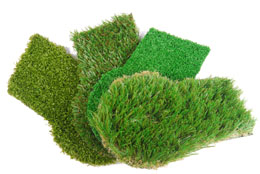Artificial or synthetic turf is very popular on sports grounds, and on residential and commercial lawns. Here are some tips on how to install artificial turf.

A synthetic turf refers to a man-made grass-like material, and it is also called artificial turf or astroturf. It is popularly used on sports grounds, for example in football, baseball, and hockey arenas. The structure of the turf used in sports grounds varies with respect to the type of sport. In hockey arena, the turf is short in comparison to that of a football turf. In recent times, synthetic turfs have been used for creating artificial lawns in residential areas and other large commercial complexes.
The modern synthetic turf consists of an expanded polypropylene base over which the other components are attached. Green-colored straight fibers (1.5-2.5 inch) that are coated with silicone are arranged along with short curly fibers. These curled fibers are meant to support and keep the straight fibers upright. At the base of the fibers, rubber granules about 1 inch in thickness are added to keep the turf soft. This technology may vary with respect to the brand.
Installation
Installation of artificial turf is easy, provided you follow certain guidelines for laying the turf. First of all, mark the area where you are planning to install the turf. Measure and note down the dimension of the area carefully. Any large stones, weeds, and grasses should be removed prior to the installation. Following this, remove the top layer of the soil. Allow it to dry for about a week, and then, set a layer of crushed stone (25-75 mm) in the area. For an unstable soil type, you require to lay about 100-150mm of base material.
Level the area evenly by making use of a rake. You can use vibrating compactor in order to provide compaction to the base material. For better installation of the artificial turf, apply a thin layer of sand. It is not compulsory to spray sand, and you can skip this step if the crushed stone is smooth and even. Check for deep depressions, and if they are present, re-level the area. The next step is rolling out the synthetic turf. You can roughly cut the excess turf by using a sharp blade.
After laying and leveling the turf, carefully trim it off in accurate straight lines. If you are using the pieces of turf, then start laying them from the center. While doing so, ensure that they lay in the same direction. Cut the sides of the next piece to match the previous piece, and proceed following the same. Apply adhesives along the seams to adhere the turf properly. Finally, secure the installed turf by placing 6 inch nails after every 25 inch of the turf. Add and spread infill material (sand or rubber granules) with the help of a broom.
Advantages and Disadvantages
There are several advantages of synthetic turf. It is an obvious fact that artificial lawns require very less maintenance in comparison to turfgrass lawns. Easy drainage during rainy season is possible, which is not so in case of real grass. Another advantage is the conservation of water, which is beneficial in areas facing water scarcity. Artificial turf is highly durable, and a superior quality turf may even last for about 10 years. It can be used for creating greenery in landscapes where the condition is not favorable for growing natural turfgrass. Speaking about the disadvantages, it builds up excessive heat and requires occasional disinfection to kill pathogens.






 A synthetic turf refers to a man-made grass-like material, and it is also called artificial turf or astroturf. It is popularly used on sports grounds, for example in football, baseball, and hockey arenas. The structure of the turf used in sports grounds varies with respect to the type of sport. In hockey arena, the turf is short in comparison to that of a football turf. In recent times, synthetic turfs have been used for creating artificial lawns in residential areas and other large commercial complexes.
A synthetic turf refers to a man-made grass-like material, and it is also called artificial turf or astroturf. It is popularly used on sports grounds, for example in football, baseball, and hockey arenas. The structure of the turf used in sports grounds varies with respect to the type of sport. In hockey arena, the turf is short in comparison to that of a football turf. In recent times, synthetic turfs have been used for creating artificial lawns in residential areas and other large commercial complexes.